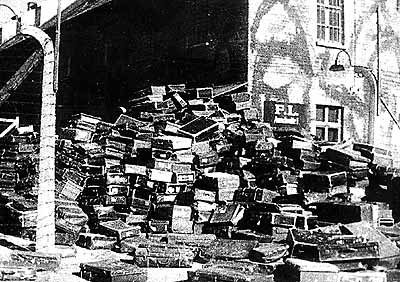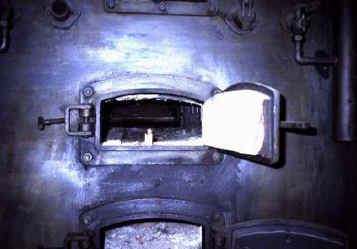|

|
|
Theresienstadt was
established on Nov. 24, 1941 near Prague, Czechoslovakia. The Nazis used
it as a model ghetto for propaganda purposes. The Nazis also created
Theresienstadt to fool the outside world into believing that they were
treating the Jews well. But soon the camp was one of the worst in
Europe. Of the 140,000 Jews who were sent to Theresienstadt, over
33,000 died there, 88,000 were deported then killed, and about 20,000
survived. |
|
Jakob Edelstein,
who was a member of the Czech-Jewish community, believed that it would
be better for his community to be concentrated locally rather than sent
to the East. Edelstein hoped that the ghetto would be in a section of
Prague, but the Nazis chose the town of Terezin. Terezin is
located about ninety miles north of Prague and just south of Litomerice.
Terezin consisted of The Big Fortress and The Small Fortress. The Big
Fortress was surrounded by ramparts and contained barracks. The Small
Fortress was used as a prison for dangerous criminals. Terezin changed
when the Nazis renamed it Theresienstadt and sent the first Jewish
transports there in 1941.
|
|
The Nazis sent
about 1,300 Jewish men on two transports to Theresienstadt on Nov. 24
and Dec. 4, 1941. These workers, made up of the Aufbaukommando
(construction detail), later known as the AK1 and AK2 in the camp. These
men were sent to work on the garrison town. The largest problem they
faced was changing a town that needed to hold about 35,000 to 60,000
people. The camp lacked housing, bathrooms, water, and electricity. To
solve these problems, the Nazis selected Jakob Edelstein Elder of the
Jews, or Judenalteste. They also made a Juderant, or a Jewish council.
|
|
What many people
didn't know that within this calm facade lay a concentration camp.
With nearly 60 thousand Jews in an area that was supposed to hold 7
thousand. It had extremely close quarters, a lot of disease, and
lack of food were also serious concerns. Some people like Norbert
Troller had enough information in advance to know how to hide his
valuables. Others, especially the elderly, were fooled but the
Nazis. They believed that they were going to a resort or
spa. Some of the elderly actually paid large sums of money for a
decent location within their new home. When they arrived, they
were housed in the same places where the other people were. To get to
Theresienstadt, thousands of Jews, from Orthodox to Assimilated, were
deported from their old homes. At first, many people going to
Theresienstadt were Czech, but later German, Austrian, and Dutch Jews
arrived in the camp. These Jews were crammed into cattle cars with
little or no food, water, and sanitation.
|
|
The trains were
unloaded at Buhsovice, the nearest station to Theresienstadt. It
was about 2 km away. the Jews were then forced to walk the rest of
the way, carrying all of their luggage. Once the Jews reached
Theresienstadt, they went to a checking point (called a flood gate or
Schleuse in camp slang). The Jews then had their personal
information written down and put in an index. Then, they were
searched. Mostly, the Nazis and Czech gendarmes were looking for
jewelry, money, cigarettes, as well as items not allowed in the camp
such as hot plates and cosmetics. During the initial process, the
Jews were assigned to their housing.
|

These are the suitcases of the Jews. The
suitcases had valuables in them. The Nazis guarded them, sorted
them, and stole them form the Jews. |
| One of the many problems with pouring
thousands of people into a small space has to do with housing.
Triple-tired bunk beds were made and every available floor space was
used. The living/sleeping areas were covered with vermin.
These pests included rats, fleas, flies, and lice. Another problem
was food. In the beginning, there weren't enough cauldrons to cook
food for all of the people. In 1942, the inhabitants who worked at
hard labor received the most food. Usually the elderly received
the least food and it affected them the most. Lack of nourishment,
medicines, and general susceptibility to illness made their fatality
rate extremely high.
|
|
Of the thousands of people that died,
15,000 children died, and only 132 survived. Those who died were
usually wrapped in a sheet and buried. But the lack of food,
medicines, and space made the bodies outgrow the possible locations for
graves. In Sept. 1942, a crematorium was built. The
crematorium could dispose up to 190 bodies a day. Once the ashes
were searched for gold, usually from gold teeth, they were put in a
cardboard box and stored. Near the end or the war, the Nazis tried
to cover their tracks by disposing of the ashes. They dumped 8,000
boxes into a pit and 17,000 boxes into the Ohre River.
|

This is a picture of a crematorium used at
Theresienstadt. When the Jews died, the Nazis burned the bodies to
make room at the camp because burying the bodies took up too much room. |